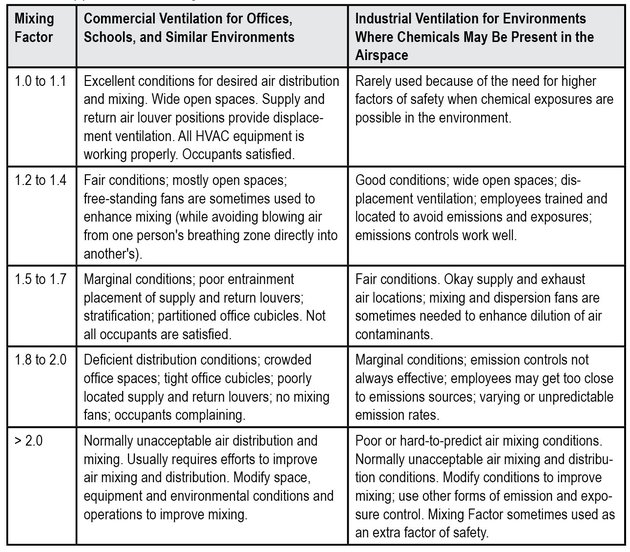DEPARTMENTS

INDOOR AIR QUALITY
D. JEFF BURTON, MS, PE, FAIHA (former CIH and CSP, VS), is an industrial hygiene engineer with broad experience in ventilation used for emission and exposure control. He is an adjunct faculty member at the Rocky Mountain Center for Occupational and Environmental Health at the University of Utah in Salt Lake City.
Send feedback to The Synergist.
A Primer on Mixing Factors
Tips for Providing Desired Minimum Airflows to All Occupied Locations in a Space
BY D. JEFF BURTON
In this COVID-19 era, effective ventilation is more important than ever. For example, if you desire to provide at least 4 air changes per hour (ACH) to every student in a school classroom, or a minimum of 20 cubic feet per minute (cfm) of fresh outside air for each person (OA/person) in an open office complex, you will want to do what you can to help ensure that the desired airflow is actually getting to every student or to every office worker.
Using complex methods that involve measurements of temperature and carbon dioxide, computational fluid mechanics, and tracer gases, we can estimate the actual amount of air getting to a specific spot. We might then be able to report, “Measurements suggest we’re getting 25 cfm of fresh outdoor air to Ed’s desk out in the open area, but in the first cubicle, Rae’s desk is only seeing about 15 cfm. We need to increase the airflow so Rae gets 20 cfm.”
Sometimes a complex issue like this one can be simplified through “professional experience” and “rules of thumb.” In this case we sometimes use “Mixing Factors” or “Effectiveness Factors,” which are rough estimates of the added airflow needed to increase our confidence that appropriate airflow rates are being distributed to all areas of concern. Such factors have been published by ASHRAE, AIHA, ACGIH, and others. They haven’t all agreed with each other, but that is understandable, given the complexity of the subject. Note that airflow standards such as ASHRAE 62 assume perfect distribution and mixing of the air in the space being served and provide what are generally considered to be minimum values. Unfortunately, perfect distribution and mixing rarely happens.
Estimating a Mixing Factor. As an example, let’s assume we desire to supply a minimum airflow rate of 80 cfm to every cubicle in an office space, and that the supply air includes about 20 cfm of outdoor air (OA). A tracer gas study indicated that only about 60 cfm (15 cfm of OA) was delivered to some cubicles at various times during normal operation. According to ASHRAE, the Effectiveness Factor for this situation would be Ef = 60/80 = 0.75. The Mixing Factor, Kmix, is the inverse of Ef (approximately 1.33). So, to help provide at least 80 cfm of airflow to every cubicle, the total airflow would be increased using the equation
or 60 cfm · 1.33 = 80 cfm. Note that increasing the total airflow by 33 percent would not guarantee that every location would receive at least 80 cfm, but we’d likely come close to that goal as long as nothing else changed in the space.
Space configurations. The main airflow configurations in a space are often designated as “displacement” and “entrainment” ventilation. Displacement ventilation typically has air supply and return vents on opposite sides of the space—for example, in the floor with air going to the ceiling, or on the south wall with air traveling to the north wall. Entrainment ventilation typically has both supply and return vents in the floor, or both in the ceiling, or poorly placed in the space. Displacement ventilation approaches are typically considered to be better for air mixing and distribution than entrainment approaches. Displacement ventilation is more common in industrial settings and labs where chemical compounds are encountered. Offices, schools, homes, and commercial spaces are often configured in various entrainment airflow patterns. Some spaces may be combinations of both.
Guidelines. Table 1 provides two sets of approximate Mixing Factors that I have constructed from available sources and my own experiences. It assumes that the air supply, return, and exhaust fans are on and running as intended. When the environment is not clearly understood, choosing a higher Mixing Factor from Table 1 provides an extra factor of safety, which is particularly good for industrial ventilation sites. Always check after applying these factors to ensure that goals have been met and occupants are safe and satisfied. Also keep in mind that the higher the factor, the more incentive you will have to improve air distribution and mixing in the space.
Table 1. Approximate Mixing Factor Guidelines

Tap on the table to open a larger version in your browser.
Mixing Factors as high as 5–10 have been proposed in the past, but actually using such high factors could be costly and unnecessary for modern buildings and HVAC systems and suggests the need to modify the environment to enhance mixing and distribution. Note that Mixing Factors may vary between heating and cooling seasons and may be affected by environmental conditions, such as wind blowing through an open window.
Case Study 1. At a recently remodeled open office space now consisting of 16 newly installed cubicles, about one-third of the occupants were complaining of stale air, odors, sneezing, and upper respiratory irritations. Other occupants seemed fine with conditions. The complaints suggested inadequate airflow to some cubicles. The new cubicles, which were constructed with solid, seven-foot-high partitions on three sides of each desk, were intended to allow higher occupancy and provide more privacy and noise control. The airflow rates and the air supply and return locations in the ceiling, which approximated an entrainment placement, were not changed at the time of the “upgrade.”
Looking at the guidelines in Table 1, it appears that Kmix could be 1.5 or even higher. The existing HVAC system was capable of providing 20 percent more airflow, which would be associated with a Kmix of 1.2. The OEHS staff thus decided it was necessary to also improve air distribution and mixing by increasing the number of air supply and return vents in the ceiling and adjusting their locations, providing small air mixing fans to each cubicle occupant (also instructing them not to blow their breathing zone air directly toward someone else), and raising the cubicle partitions about six inches above the floor. After these changes and the 20 percent increase in airflow, complaints dropped considerably during both heating and cooling seasons.
Case Study 2. In a new bench-type chemical lab design, OEHS professionals worked with lab designers to optimize air distribution and mixing by providing displacement ventilation—for example, air exhaust louvers were located on the wall opposite to where supply air entered the lab, no barriers were allowed between adjacent lab benches, lab bench operations were designed to minimize chemical emissions during use, and lab technicians were to be given training to minimize emissions. Based on the estimated maximum emissions and required dilution ventilation rate, the OEHS professionals chose to equip the lab with a system that provided 8 outdoor air changes per hour (OACH). Then, looking at Table 1 for environments with industrial ventilation, the OEHS professionals thought the Mixing Factor would likely be in a low category (Kmix = 1.2–1.4), so the design value for air exchange was increased by 25 percent (Kmix = 1.25), which resulted in supplying 10 OACH in the space: Qoa = 8 x 1.25 = 10 OACH.
RESOURCES
ACGIH: Industrial Ventilation Manual, 29th ed., chapter 4.
AIHA: The Occupational Environment: Its Evaluation, Control, and Management, 3rd ed., chapter 36.
AIHA: IAQ and HVAC Workbook, 4th ed., chapter 13.
ASHRAE: Fundamentals Handbook.
ASHRAE: HVAC Applications, chapter 20.
ASHRAE: Standard 62.1-2019, Ventilation for Indoor Air Quality, Table 6-2, “Air Distribution Effectiveness.”
CDC: “Guidelines for Environmental Infection Control in Health-Care Facilities” (2003).
CDC: “Guidelines for Environmental Infection Control in Health-Care Facilities, Appendix B. Air” (2003).
CDC: “Guidelines for Environmental Infection Control in Health-Care Facilities, Background C. Air” (2003).
EPA: “Ventilation and Air Quality in Offices” (PDF, 1990).
Smart Air: “ASHRAE Recommended Air Changes Per Hour” (2020).
University of California Berkeley: Air Movement, Ventilation and Comfort in a Partitioned Office (PDF, 1992).

